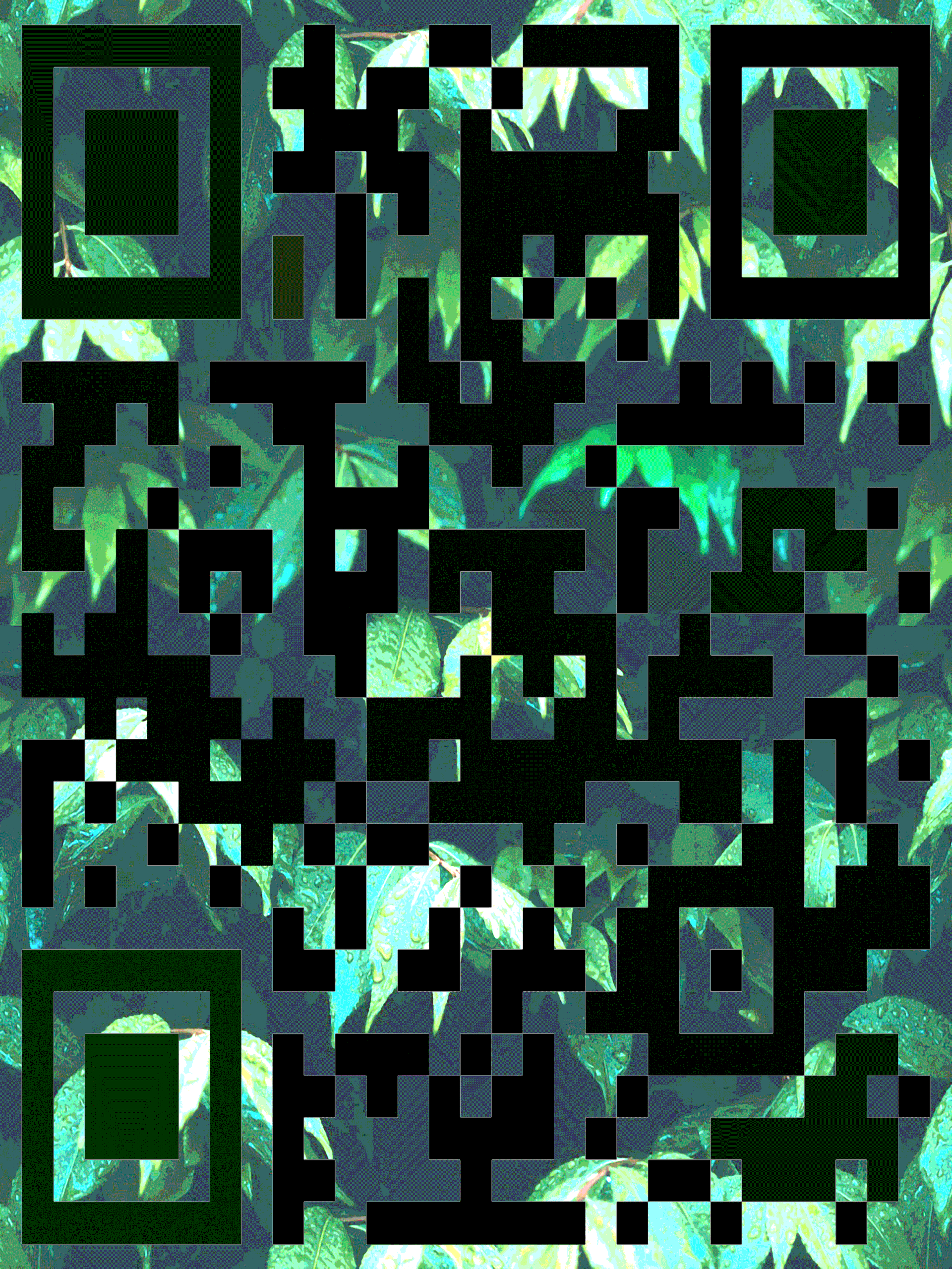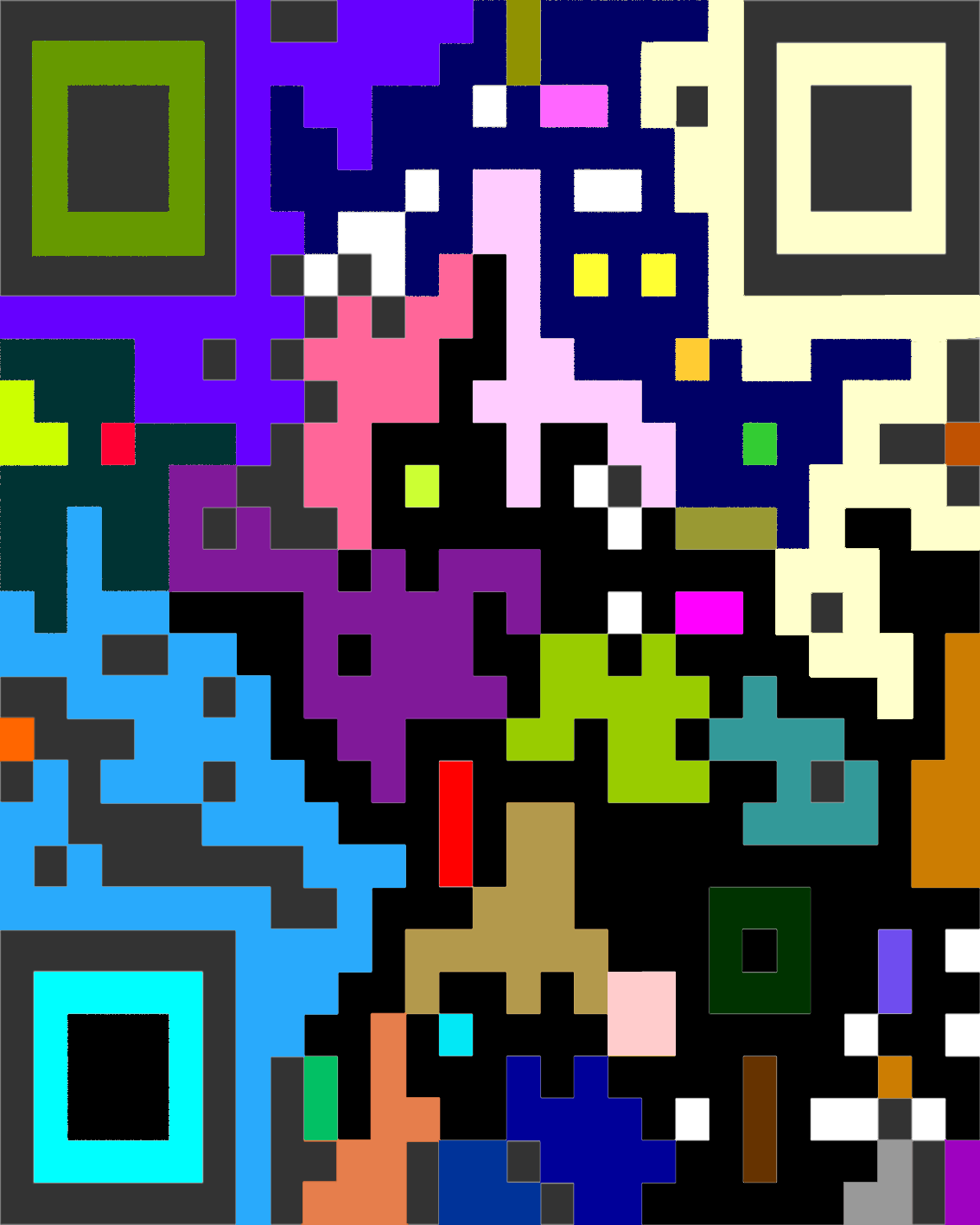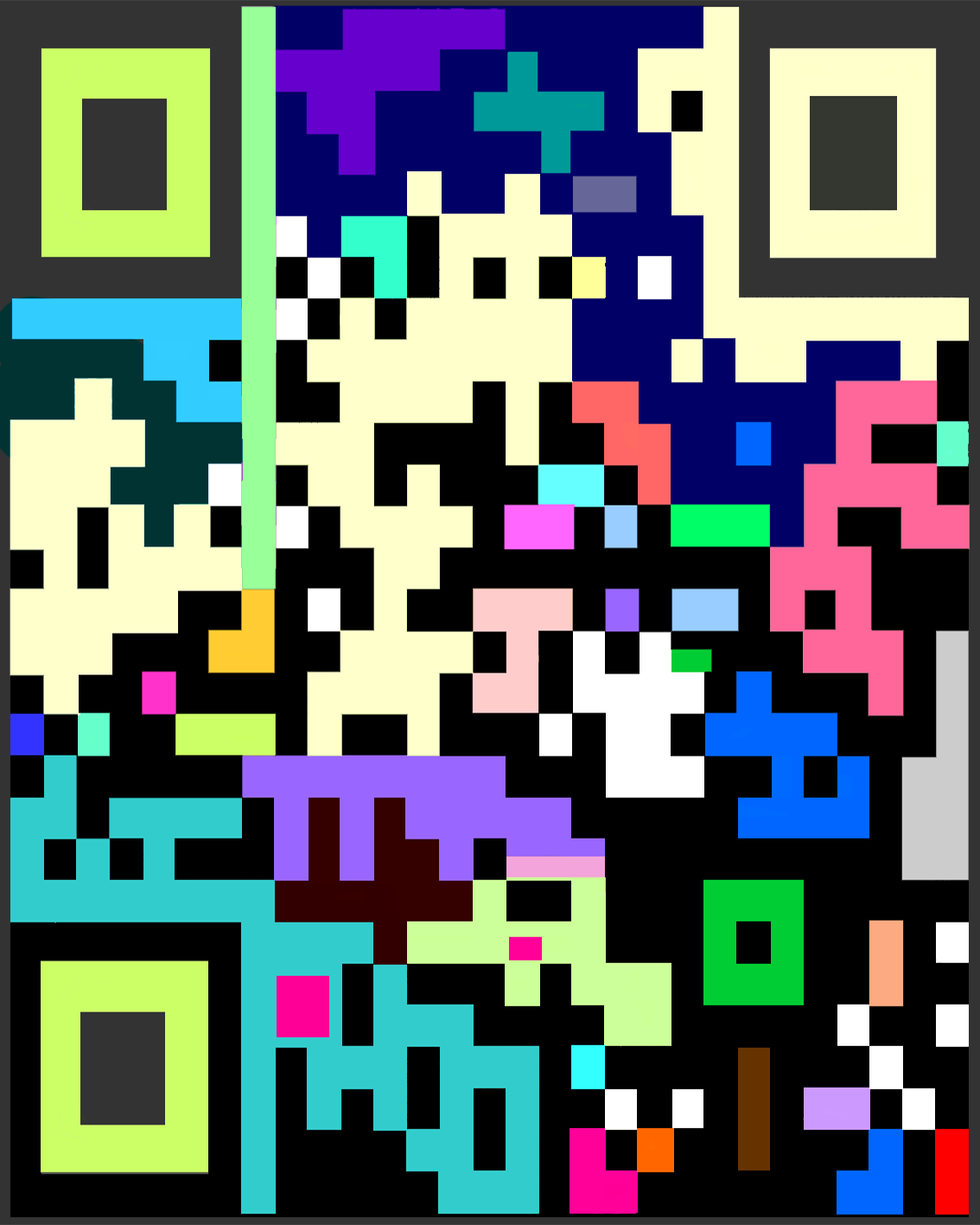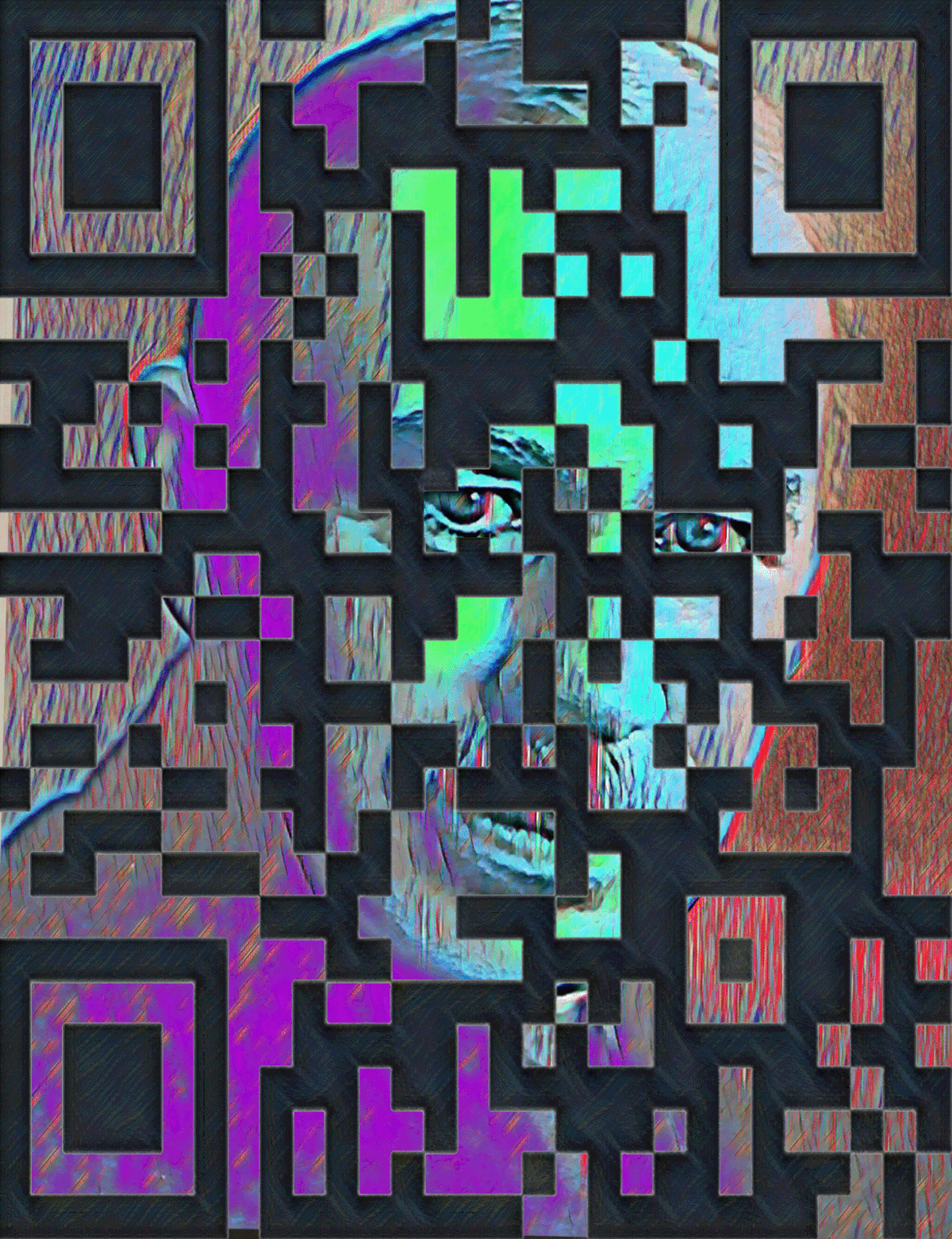What You GET IS What You SEE
EXPLORING THE MODERN MEANING OF ART
Serie Prima

Java (2020)

Blockchained (2020)

Giraffe (2021)

What You See Is What You Get

JMK (2021)
Non-MANIFESTO of the atomistic artist
In this project, I solicit concepts of philosophy and economic theory to expand the boundaries of art definitions. By blending together conceptual art and visual art, I explore the ambivalent relationship between “aesthetic value” and “economic value” in art, and the effects on the contemporary artist's creative process facing a dilemma between producing for creativity or for the market. I use this theoretical framework to provide an artistic representation of this dichotomy using blockchain certification through Verisart. By exploiting the “error correction property”, I alter QR codes while preserving their readability to generate certificates of authenticity that become themselves the artwork, and call the observer to the resolution of the artist's dilemma.
***
In art philosophy, there is wide agreement that most artworks are made to be appreciated, and that a significant amount of art appreciation is aesthetic (Ribeiro, 2012). However, whether art can be defined, theorised, or at least broadly conceptualised is still an open question.
When it comes to art definitions, over the past decades the literature has reached the consensus that a consensus cannot be reached. On the one hand, there is a view that supports some sort of broad institutional definition, which states that a work of art is an “artefact upon which some persons acting on behalf of the artworld has conferred the status of candidate for appreciation” (Dickie, 1974). On the other hand, there is a skeptical view, which can be summarised in one quote: “art is undefinable” (Weitz, 1956). The divide concerns particularly the nature of the aesthetic and its precise relation to what is art and what is not, in a context in which beauty is necessarily subjective, and contingent to time and space.
The contemporary art scene is populated by uncountable instances of artworks whose beauty might be “objectively” questionable to say the least, or at least to the eyes of many outsiders of the relevant institutions, the so called artworld. Often, the realization of many of these artworks does not even seem to require particular technical challenges. Nevertheless, they are often auctioned at impressive record-highs. How is that possible?
To explain the apparent discrepancy, “subjectivity” is often invoked as a popular argument. Aesthetics and taste –the argument goes– belong to the most inner domain of individual emotions, and respond to the sensorial perception of the observer. If “beauty is in the eyes of the beholder” , then all and nothing can coexist.
But there is more.
***
In a recent BBC podcast, Mark Carney, former governor of the Bank of England, provides a narrative of how the shift from “moral sentiments” to “market sentiments” have led to determining how we get what we value in the modern society. The argument points to the overlap of “financial value” over “society's value” as a co-cause of several crises of this century, including COVID and climate.
In this project, I borrow that view to argue that art has massively undergone a likewise transformation, leading art production to evolve dystopically towards the fusion –and confusion– of “price” and “value”. In this environment, art overtakes definitions to be anything that can be traded in marketplaces, which determine de facto the market value of art.
The rapid development of the so-called “non-fungible tokens” (NFTs) and some of their evaluations give a measure of the collision between art objects and financial objects. Can these “objects” be considered art? If art reflects the events of the times in which it is produced, then the answers is a definitive “yes”. Many observers might be tempted to label those as bubbly phenomena, similar in fashion to the Dutch tulipmania of the 17th century. However, relegating them to the status of speculative financial bubbles attached to intrinsically useless assets would be reductive, if not a mistake. Others, might argue that NFTs are nothing but a modern version of otherwise standard collectibles such as postage stamps. I argue that they are neither one nor the other. The possibility to create certificates of authenticity with a blockchain technology makes them uniquely identifiable, facilitating the transfer of ownership in standardised marketplaces. As such, they are just like any other security issued by artists in search for institutional recognition, or assets backed by the artistic reputation of the issuer. Then some questions arise. Are contemporary artworks still being produced to be appreciated (along the traditional art definition) or to be owned as a financial investment? In this context, who are then the relevant institutions?
***
FROM CREATIVE DISRUPTION TO THE DESTRUCTION OF CREATIVITY
If artworks are just like any other financial asset or commodity priced in financial markets, art objects become valuable so long as there is enough demand to sustain them. In this perspective, art appreciation abstracts from aesthetics as the “financial value” is the metric quantifying how individuals –in the modern society– get what they value. This shift of paradigm, however, is not new. In philosophy and economics, it can be identified with the transition from the “objective” theory of value of classical economists (Aristotle, Bentham, Smith, Ricardo, Marx) to the “subjective” theory of value (Jevons, Menger, Walras). Trends in the art market suggest a likewise transformation in the art world, the definitive transition from classical utilitarianism to neoclassical marginalism.
The quest for institutional recognition, directly or indirectly, affects the artist’s creative process. In the context just described, the creative process is necessarily constrained, invalidated: it is subject to dynamics that do not merely respond to the artist's primordial need of self-expression. This prevents artists to fully execute their social role of genuinely conveying, through sensorial tools, the expression of emotions, desires, or social criticism. Creativity is thus jeopardised by a set of exogenous forces, limiting the space for manoeuvre of the artist's exploratory task of reinterpreting the world through critical lens. This inhibits the latent power of art to become creatively disruptive.
In the competitive race for public attention, and driven by popularity judgements, the artist adapts to adopt, consciously or not, a strategic behaviour similar in spirit to a concept known in economic theory as the “Keynesian beauty context” (Keynes, 1936). In the application of this revisited concept that I hereby propose, artists are (and know to be) potentially rewarded for a creative outcome that targets economic value, rather than one that may personally find the most attractive and meaningful. The artist faces a dilemma between letting or resisting exogenous –market– forces influence the creative process while enduring the realisation of the modern meaning of art, the transformation of society's shift from aesthetic value to financial value.
The contemporary artist internalises this dilemma, but due to its atomistic nature can only undergo the fait accompli, the process of “marketisation”. In the struggle for survival, the atomistic artist attempts to face the dilemma and, willingly or not, consciously or not, resolves to gives up l’art pour l’art to become a commodity.
Markets become the institution.
***
AN ARTISTIC REPRESENTATION
In the series of artworks presented, I crystallise the dilemma faced by the atomistic contemporary artist: produce for art or for value. By providing an artistic representation of this dichotomy, I also enable the observer to actively participate to this dilemma and, potentially, to its resolution. I thus empower the observer to choose what to see and so to determine the value of the art object.
My approach can be seen as a reverse exercise carried out by the philosopher. While philosophers attempt to define art, I adopt an artistic approach to explore the philosophical meaning of art in the modern society.
As for the methodology, I first exploit the availability of blockchain certification to generate certificates of authenticity identified univocally by a QR code. Next, I incubate my creative process by using the QR code as an element of the canvas to build my artwork. The QR code does indeed becomes the canvas on which I create patterns that intentionally camouflage with the QR code. Therefore, I technically produce artworks in which the certificate of authenticity is itself the art object.
Conceptually, I elicit the observer’s sensorial perception to decide what to see, along a surrealist perspective. The observer's decision can be seen as the co-participation to the artist's dilemma. Just as the artist faces the dilemma of producing art either for artistic gratification or for the market, so does the observer in facing the dilemma of possessing art either for the arousing sensorial experience, or for the associated economic appreciation of holding the artwork for a given period of time.
This decision, however, is not only philosophical, but I make it material. Through the use of most popular device used in our daily life –the smartphone, the observer undertakes a decision on what to see. Placed in front of the artwork, the observer can choose to either select the camera shutter and obtain gratification through an eye that priorities the aesthetic appreciation of the artwork, or select the QR code shutter, which ignores the artwork, thus its aesthetic value, to only capture the QR code pattern, an action that redirects the observer to the certificate of authenticity, that is, the artwork's economic value.
In either way, through my artworks, I elevate the observer as the representative agent of the artworld, and place the observer at the centre of the dilemma resolution. The observer becomes the one to decide what to value by deciding what to see.
“What You Get, Is What You See”.
References
“Defining Art,” A. Ribeiro (ed.) 2012, pp. 39–56.
“Art and the Aesthetic: An Institutional Analysis”, G. Dickie, Cornell University Press, 1974.
“The Role of Theory in Aesthetics”, M. Weitz, Journal of Aesthetics and Art Criticism, 1956.
“From Moral to Market Sentiments”, M. Carney, The Reith Lectures, 2020.
“The General Theory of Employment, Interest and Money”, J.M. Keynes, 1936, Ch. 12.
Published on March 20, 2021
share iF YOU LIKE